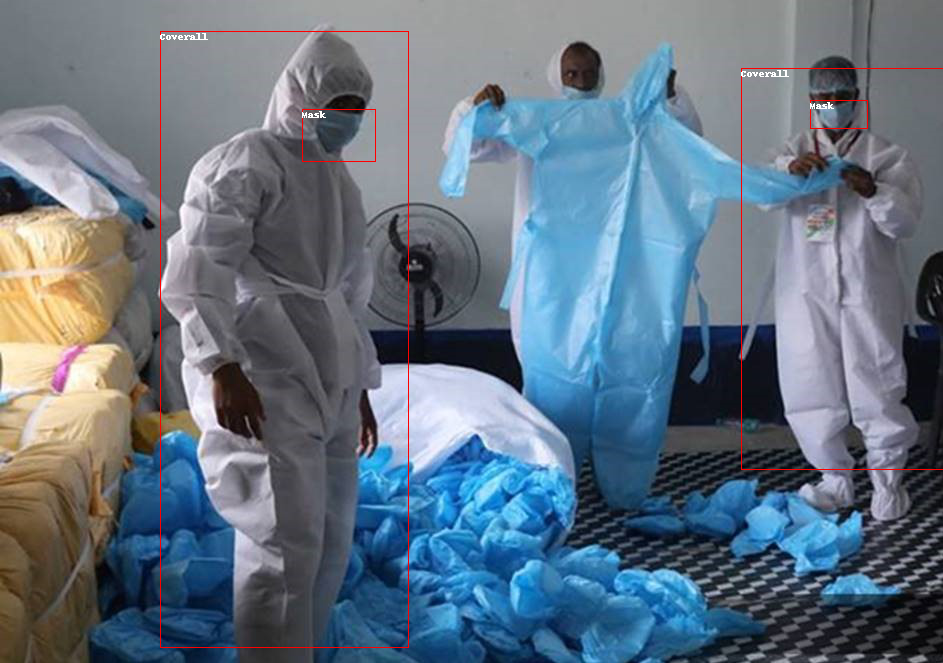使用DETR模型在CPPE-5数据集上Finetune,主要包括三个步骤:
- 数据集处理
- 模型训练和验证
- 模型推理
确保已经安装以下依赖库:
pip install -q datasets transformers evaluate timm albumentations使用datasets加载数据集,使用albumentations增强数据集,使用transformers训练模型。
import datasets
from datasets import load_dataset
config = datasets.DownloadConfig(resume_download=True, max_retries=100)
cppe5 = load_dataset(
path="/data/huggingface/data/cppe-5",
download_config=config,
)
print(cppe5)
print(cppe5["train"][0])
我是提前把数据集下载好放到别的目录下。
CPPE-5数据集包含带有标注的图像,用于识别COVID-19大流行背景下的医疗个人防护装备(PPE)。
该数据集包含1000个图像的训练集和一个包含29个图像的测试集。
{'image_id': 15,
'image': <PIL.JpegImagePlugin.JpegImageFile image mode=RGB size=943x663 at 0x7F9EC9E77C10>,
'width': 943,
'height': 663,
'objects': {'id': [114, 115, 116, 117],
'area': [3796, 1596, 152768, 81002],
'bbox': [[302.0, 109.0, 73.0, 52.0],
[810.0, 100.0, 57.0, 28.0],
[160.0, 31.0, 248.0, 616.0],
[741.0, 68.0, 202.0, 401.0]],
'category': [4, 4, 0, 0]}
}
每个样本包含以下字段:
-
image_id: 图片id -
image: PIL.Image对象 -
width: 图片宽度 -
height: 图片高度 -
objects一个字典,表示图片中包含的内容:
id: 标注idarea:bounding box面积bbox: COCO 格式 的bboxcategory: 目标类别Coverall (0),Face_Shield (1),Gloves (2),Goggles (3)andMask (4)
还需要对数据进行转换成DETR模型需要的格式。
先可视化看看数据。
import numpy as np
import os
from PIL import Image, ImageDraw
image = cppe5["train"][0]["image"]
annotations = cppe5["train"][0]["objects"] # 标注
draw = ImageDraw.Draw(image)
categories = cppe5["train"].features["objects"].feature["category"].names
print(categories)
id2label = {index: x for index, x in enumerate(categories, start=0)}
label2id = {v: k for k, v in id2label.items()}
for i in range(len(annotations["id"])):
box = annotations["bbox"][i]
class_idx = annotations["category"][i]
x, y, w, h = tuple(box)
draw.rectangle((x, y, x + w, y + w), outline="red", width=1)
draw.text((x, y), id2label[class_idx], fill="white")
image.save("./res.jpg")用于对象检测的数据集的一个常见问题是边界框“拉伸”到图像边缘之外。这种“失控”的边界框可能会在训练过程中引发错误,应在现阶段加以解决。在这个数据集中有几个关于这个问题的数据样本,需要加以剔除。
remove_idx = [590, 821, 822, 875, 876, 878, 879]
keep = [i for i in range(len(cppe5["train"])) if i not in remove_idx]
cppe5["train"] = cppe5["train"].select(keep)要微调模型,必须对数据进行预处理,以精确匹配预训练模型所使用的方法。AutoImageProcessor负责处理图像数据,以创建DETR模型可以训练的pixel_value、pixel_mask和labels。图像处理器具有一些属性:
image_mean = [0.485, 0.456, 0.406 ]image_std = [0.229, 0.224, 0.225]
这些是在模型预训练期间用于归一化图像的平均值和标准偏差。在对预先训练的图像模型进行推断或微调时至关重要。
- 加载图像处理器
from transformers import AutoImageProcessor
checkpoint = "facebook/detr-resnet-50"
image_processor = AutoImageProcessor.from_pretrained(
checkpoint, cache_dir="/data/bocheng/huggingface/model/"
)在使用图片处理器进行处理之前先对图像进行增强处理。
import albumentations
import numpy as np
import torch
import albumentations
import numpy as np
import torch
# 图像增强操作
transform = albumentations.Compose(
[
albumentations.Resize(480, 480),
albumentations.HorizontalFlip(p=1.0),
albumentations.RandomBrightnessContrast(p=1.0),
],
bbox_params=albumentations.BboxParams(
format="coco", label_fields=["category"]
), # bbox的类型 coco [x_min, y_min, width, height]
)并把标注转换成期望的格式。
def formatted_anns(image_id, category, area, bbox):
annotations = []
for i in range(0, len(category)):
new_ann = {
"image_id": image_id,
"category_id": category[i],
"isCrowd": 0,
"area": area[i],
"bbox": list(bbox[i]),
}
annotations.append(new_ann)
return annotations
# transforming a batch
def transform_aug_ann(examples):
image_ids = examples["image_id"]
images, bboxes, area, categories = [], [], [], []
# 处理一个batch的图片
for image, objects in zip(examples["image"], examples["objects"]):
image = np.array(image.convert("RGB"))[:, :, ::-1] # 转换为RGB图像格式,再转换为RGB通道顺序
# 图像增强
out = transform(
image=image, bboxes=objects["bbox"], category=objects["category"]
)
area.append(objects["area"])
images.append(out["image"])
bboxes.append(out["bboxes"])
categories.append(out["category"])
targets = [
{"image_id": id_, "annotations": formatted_anns(id_, cat_, ar_, box_)}
for id_, cat_, ar_, box_ in zip(image_ids, categories, area, bboxes)
]
return image_processor(images=images, annotations=targets, return_tensors="pt")
cppe5["train"] = cppe5["train"].with_transform(transform_aug_ann)
print(cppe5["train"][15])
定义一个collate_fn
def collate_fn(batch):
pixel_values = [item["pixel_values"] for item in batch]
encoding = image_processor.pad(pixel_values, return_tensors="pt")
labels = [item["labels"] for item in batch]
batch = {}
batch["pixel_values"] = encoding["pixel_values"]
batch["pixel_mask"] = encoding["pixel_mask"]
batch["labels"] = labels
return batchfrom transformers import AutoModelForObjectDetection, DetrForObjectDetection, DetrConfig
# checkpoint = "facebook/detr-resnet-50"
model = DetrForObjectDetection.from_pretrained(
pretrained_model_name_or_path=checkpoint, # os.path.join(checkpoint, "pytorch_model.bin"),
id2label=id2label,
label2id=label2id,
ignore_mismatched_sizes=True,
cache_dir="/data/bocheng/huggingface/model/",
)
from transformers import TrainingArguments
training_args = TrainingArguments(
output_dir="detr-resnet-50_finetuned_cppe5",
per_device_train_batch_size=8,
num_train_epochs=10,
fp16=True,
save_steps=200,
logging_steps=50,
learning_rate=1e-5,
weight_decay=1e-4,
save_total_limit=2,
remove_unused_columns=False,
)
from transformers import Trainer
trainer = Trainer(
model=model,
args=training_args,
data_collator=collate_fn,
train_dataset=cppe5["train"],
tokenizer=image_processor,
)
trainer.train()def val_formatted_anns(image_id, objects):
annotations = []
for i in range(0, len(objects["id"])):
new_ann = {
"id": objects["id"][i],
"category_id": objects["category"][i],
"iscrowd": 0,
"image_id": image_id,
"area": objects["area"][i],
"bbox": objects["bbox"][i],
}
annotations.append(new_ann)
return annotations
# Save images and annotations into the files torchvision.datasets.CocoDetection expects
def save_cppe5_annotation_file_images(cppe5):
output_json = {}
path_output_cppe5 = f"{os.getcwd()}/cppe5/"
if not os.path.exists(path_output_cppe5):
os.makedirs(path_output_cppe5)
path_anno = os.path.join(path_output_cppe5, "cppe5_ann.json")
categories_json = [
{"supercategory": "none", "id": id, "name": id2label[id]} for id in id2label
]
output_json["images"] = []
output_json["annotations"] = []
for example in cppe5:
ann = val_formatted_anns(example["image_id"], example["objects"])
output_json["images"].append(
{
"id": example["image_id"],
"width": example["image"].width,
"height": example["image"].height,
"file_name": f"{example['image_id']}.png",
}
)
output_json["annotations"].extend(ann)
output_json["categories"] = categories_json
with open(path_anno, "w") as file:
json.dump(output_json, file, ensure_ascii=False, indent=4)
for im, img_id in zip(cppe5["image"], cppe5["image_id"]):
path_img = os.path.join(path_output_cppe5, f"{img_id}.png")
im.save(path_img)
return path_output_cppe5, path_anno
import torchvision
class CocoDetection(torchvision.datasets.CocoDetection):
def __init__(self, img_folder, image_processor, ann_file):
super().__init__(img_folder, ann_file)
self.image_processor = image_processor
def __getitem__(self, idx):
# read in PIL image and target in COCO format
img, target = super(CocoDetection, self).__getitem__(idx)
# preprocess image and target: converting target to DETR format,
# resizing + normalization of both image and target)
image_id = self.ids[idx]
target = {"image_id": image_id, "annotations": target}
encoding = self.image_processor(
images=img, annotations=target, return_tensors="pt"
)
pixel_values = encoding["pixel_values"].squeeze() # remove batch dimension
target = encoding["labels"][0] # remove batch dimension
return {"pixel_values": pixel_values, "labels": target}
# im_processor = AutoImageProcessor.from_pretrained(
# "./detr-resnet-50_finetuned_cppe5/checkpoint-1200"
# )
path_output_cppe5, path_anno = save_cppe5_annotation_file_images(cppe5["test"])
test_ds_coco_format = CocoDetection(path_output_cppe5, image_processor, path_anno)
import evaluate
from tqdm import tqdm
model = AutoModelForObjectDetection.from_pretrained(
"./detr-resnet-50_finetuned_cppe5/checkpoint-1200"
)
module = evaluate.load("ybelkada/cocoevaluate", coco=test_ds_coco_format.coco)
val_dataloader = torch.utils.data.DataLoader(
test_ds_coco_format,
batch_size=8,
shuffle=False,
num_workers=4,
collate_fn=collate_fn,
)
with torch.no_grad():
for idx, batch in enumerate(tqdm(val_dataloader)):
pixel_values = batch["pixel_values"]
pixel_mask = batch["pixel_mask"]
labels = [
{k: v for k, v in t.items()} for t in batch["labels"]
] # these are in DETR format, resized + normalized
# forward pass
outputs = model(pixel_values=pixel_values, pixel_mask=pixel_mask)
orig_target_sizes = torch.stack(
[target["orig_size"] for target in labels], dim=0
)
results = image_processor.post_process(
outputs, orig_target_sizes
) # convert outputs of model to COCO api
module.add(prediction=results, reference=labels)
del batch
results = module.compute()
print(results)from transformers import pipeline, AutoModelForObjectDetection, AutoImageProcessor
import requests
from PIL import Image, ImageDraw
import torch
url = "/home/bocheng/dev/mylearn/CV-Learning/ObjectDetection/cppe5/1002.png"
model_path = "./detr-resnet-50_finetuned_cppe5/checkpoint-1200"
image = Image.open(url)
# 1.使用pipeline接口进行推理
# image_processor = AutoImageProcessor.from_pretrained(
# "./detr-resnet-50_finetuned_cppe5/checkpoint-1200"
# )
# model = AutoModelForObjectDetection.from_pretrained(
# "./detr-resnet-50_finetuned_cppe5/checkpoint-1200"
# )
# obj_detector = pipeline(
# "object-detection", model=model, image_processor=image_processor
# )
# out = obj_detector(image)
# for x in out:
# print(x)
# out.save("./out.jpg")
image_processor = AutoImageProcessor.from_pretrained(model_path)
model = AutoModelForObjectDetection.from_pretrained(model_path)
with torch.no_grad():
inputs = image_processor(images=image, return_tensors="pt")
outputs = model(**inputs)
target_sizes = torch.tensor([image.size[::-1]])
results = image_processor.post_process_object_detection(
outputs, threshold=0.2, target_sizes=target_sizes
)[0]
for score, label, box in zip(results["scores"], results["labels"], results["boxes"]):
box = [round(i, 2) for i in box.tolist()]
print(
f"Detected {model.config.id2label[label.item()]} with confidence "
f"{round(score.item(), 3)} at location {box}"
)
draw = ImageDraw.Draw(image)
for score, label, box in zip(results["scores"], results["labels"], results["boxes"]):
box = [round(i, 2) for i in box.tolist()]
x, y, x2, y2 = tuple(box)
draw.rectangle((x, y, x2, y2), outline="red", width=1)
draw.text((x, y), model.config.id2label[label.item()], fill="white")
image.save("./out.jpg")原文:Object detection (huggingface.co)
文章合集:chongzicbo/ReadWriteThink: 博学而笃志,切问而近思 (github.com)
完整代码:CV-Learning/ObjectDetection/detr at main · chongzicbo/CV-Learning (github.com)
